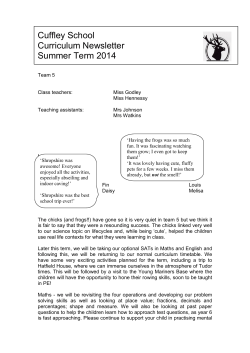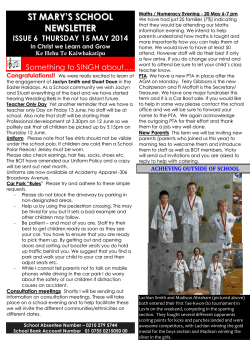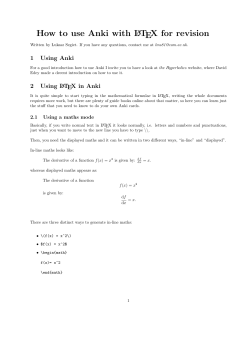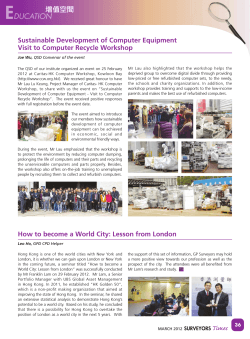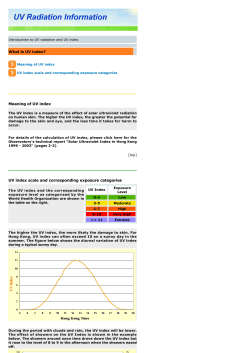
Title Why Singaporean eighth graders did better among the Asian nations... the TIMSS mathematics: a secondary analysis
Title Author(s) Source Published by Why Singaporean eighth graders did better among the Asian nations in the TIMSS mathematics: a secondary analysis Soh Kay Cheng The Mathematics Educator, 5(1),169-179 Association of Mathematics Educators This document may be used for private study or research purpose only. This document or any part of it may not be duplicated and/or distributed without permission of the copyright owner. The Singapore Copyright Act applies to the use of this document. The Mnthernntirs Erlltctrtol. 2000. Vol. 5. No //2, 169.1 79 Why Singaporean Eighth Graders Did Better Among the Asian Nations in the TIMSS Mathematics: A Secondary Analysis Soh Kay Cheng Abstract The Asian nations top the list of TIMSS mathematics achievement. This study looks for possible explanation why Singaporean eighth graders did well in TIMSS Mathematics than those of three other participating Asian nations. The analysis indicates that this could be partly due to home coilditioil and strong social motivation to do well in general and in Mathematics in particular. Homework and highly positive feelings toward Mathematics played a no small role in Singaporean students' achievement. Singaporean students attributed success more to talent or ability but less to hard work.. Singaporean's teachers spent more time on tests and assignments and used daily matters to make Mathematics lessons more relevant to the students. They also made good uses of assessment information to enhance student learning. I11 short, Singapore's Mathematics achievement is due to the illteractioil of home environment, motivation reinforced by the social milieu, teacher quality and devotion and the teaching strategies adopted by the teachers. Introduction In earlier secondary a~~alyses,So11 (1998, 1999) coinpared Maths achievement of fourth gi-aders in Three G7 nations (USA, UK, and Canada) with those in three Little Asian Dragons (Hong Kong, Korea, and Singapore). It was found that the Asian students, who outperformed their Europeail counterparts, spent more time leanling Maths. Fewer Asian students possessed the educational aids (dictionary, study desk, and colllputer) but spent more time doing homework. They did not think it is important to have time to have fun and also believed that their mothers and friends held the same attitudes. Asian teachers spent more time on out- Why Sirzgnpor-et~nE i ~ h t hGrtrder-s D i d Better Among the Asitrt~Nntio11.s in the TIMSS Mtrthernntics: A .~ecorzrlnr:j~ Arznlysis of-class coaching. They taught larger classes and did less practice of computation in their lessons. A pertinent question to ask is, Given that the Asian students do better than their European counterparts why, then, did Singaporean students did better among their Asian peers? This present analysis used the data published in the TIMSS report (Beaton, Mulis, Martin, Gonzalez, Kelly, D. L. & Smith, 1996) and compared Singaporean eighth grade students' and teachers' responses with those of Hong Kong, Korea, and Japan. The objective of this analysis is to uncover differences in various relevant measures that could have contributed to the differential perfornlance. Method Data gleaned from the various tables in the TIMSS report (Beaton et. al., 1996) are in the form of percentages of students, of teachers, or hours per day 01week. They are grouped under student responses (Table 1 ) and teacher responses (Table 2), covering the following areas: Table 1. Student response Maths achievement Maths achievement Boy-girl difference Hong Japan Korea S'pore Mean SD Kone ES 588 20 Home environment Educational aids (Dictionary, 33 desk, Computer) Books at home (More than 10 200 books) Either parent finished 7 university 605 9 607 17 643 2 610.8 23.1 12.0 8.1 1.4 -1.2 NA 38 47 39.3 7.1 1.1 NA 21 12 14.3 5.9 -0.4 NA 22 8 12.3 8.4 -0.5 Soh Kuy Cherzg Table 1 (. ..cont'd) -- Student attitudes Self: Important to do well in Maths Self: Important to do well in Science Self: Important to do well in Language Self: Important to have time to have fun Self: Important to be good at sports Perception of mothers' attitudes Mother: Important to do well in Maths Mother: Important to do well in Science Mother: Important to do well in Language Mother: Important to have time to have fun Mother: Important to be good at sports Perception of friends' attitudes Friends: Important to do well in Maths Friends: Inlportant to do well in Science Friends: Important to do well in Language Friends: Important to have time to have fun Hong Japan Korea S'pore Mean SD Kong --.-"-"--.--.-.-V.-- ES 96 92 94 99 95.3 3.0 1.3 90 87 91 99 91.8 5.1 1.4 96 91 93 100 95.0 3.9 1.3 94 99 87 96 94.0 5.1 0.4 83 83 86 89 85.3 2.9 1.3 93 NA 96 99 96.0 3.0 1.O 86 NA 92 99 92.3 6.5 1.O 93 NA 94 99 95.3 3.2 1.1 74 NA 85 79 79.3 5.5 -0.1 71 NA 72 84 75.7 7.2 1.2 86 90 86 97 89.8 5.2 1.4 74 86 79 96 83.8 9.5 1.3 87 88 81 98 88.5 7.0 1.3 93 99 88 98 94.5 5.1 0.7 Why Siizgnporenn Eighth Gmders Did Better Anlong the Asin11 Notions in the TIMSS Mothenrotics: A Secondflr:,iAncr1):sis Table l (. . .cont'd) Hong Japan Korea S'pore Mean SD Kong Friends: Important to be good 76 81 78 86 80.3 4.3 at sports Homework Out-of-school hourslday for Maths homework More than three hoursiday homework Total homework hourslday Leisure activities TVlvideo hourslday TVlvideo more than five hourslday Computer games hoursday Read a book for enjoyment hourslday Views on Maths achievement Strongly agree that usually doing well in Maths Like Maths a lot Strong positive overall attitude towards Maths Necessary to do Maths well: Natural talentlability Necessary to do Maths well: Good luck Necessary to do Maths well: Hard work Necessary to do Maths well: Memorise Need to do Maths well: Get desired job ES 1.3 0.9 0.8 0.8 1.4 1.0 0.3 1.5 30 28 29 78 41.3 24.5 1.5 2.5 2.3 2.5 4.6 3.0 1.1 1.5 2.6 11.0 2.6 9.0 2.0 7.0 2.7 6.0 2.5 8.3 0.3 2.2 0.7 -1.0 0.8 0.9 0.6 0.9, 0.3 0.8 0.6 1.1 0.6 0.9 0.2 0.1 0.1 1.4 5 4 6 11 6.5 3.1 1.4 17 9 10 3 14 5 28 20 17.3 9.3 7.7 7.6 1.4 1.4 77 82 86 84 82.3 3.9 0.5 38 59 63 41 50.3 12.6 -0.7 95 98 98 92 95.8 2.9 - 1.3 69 92 73 32 66.5 25.1 -1.4 24 12 13 37 21.5 11.7 1.3 sol^ Kny Clteng Table l ( . . .cont7d) Hong Japan Korea S'pore Mean SD Kong .. .................... ... Need to do Maths well: Please 16 6 11 20 13.3 6.1 parents Need to do Maths well: Get 32 35 35 51 38.3 8.6 into university 1. 2. 3. 4. 5. 6. 7. 8. ES 1.1 1.5 Maths achievement Home environment Student attitudes Perception of mothers' attitudes Perception of friends' attitudes Homework Leisure activities Views on Maths achievement Table 2. Teacher Respoilse ..-A Maths teachers Male Maths teachers More than 20 years teaching Maths 75% or more time teaching Maths Hourslweek preparing and erading tests Hourslweek grading students work 3 1-40 students per Maths class Hong Japan Korea S'pore Mean SD Kong ................................ .. ES ....,.,..,... 60 15 72 19 55 20 40 48 56.8 25.5 13.3 15.2 -l._> 36 37 10 25 27.0 12.6 -0.2 2.4 2.0 1.7 3.4 2.4 0.7 1.4 3.1 1.8 1.5 4.1 2.6 1.2 1.2 56 88 4 72 55.0 36.4 0.5 58 55 72 57 60.5 7.8 -0.5 20 16 13 30 19.8 7.4 1.4 -3 1.5 L Instructional strategies Reasoning tasks in most lessons Often use everyday things in problem solving Why Singclporecl11 Eighrh G~.ntle,:r Did Bcfier..4nrong the Asin11 Nntions 111 rlrc? TIMSS Mtriher~mtics: A ,Sec~orrr/nrl; Annl),.ris Table 2 (. . .cont'd) Students use calculators almost everyday Students use computer always or pretty often Homework three times or more often weekly Always collect, correct and return assignments Assessment: To provide grades or marks Assessment: To provide student feedback Assessment: To diagnose learning problen~s Assessnxnt: To report to parents Assessment: To assign students to tracks Assessment: To plan for future 9. 10. Hong Japan Korea S'pore Mean SD Kong 67 2 1 82 38.0 42.6 ES .... " 1.0 3 4 2 2 2.8 1.O -0.8 14 6 18 58 24.0 23.2 1.5 87 21 28 94 57.5 38.3 1.0 72 73 39 71 63.8 16.5 0.4 82 60 42 87 67.8 20.8 0.9 81 66 65 88 75.0 11.3 1.1 13 9 10 39 17.8 14.3 1.5 13 29 3 " 3l 19.0 13.4 0.9 74 58 56 76 66.0 10.5 1.0 Maths teachers Instructional strategies For each variable, the mean and standard deviation (of percentages) were first calculated and how far Singapore deviates from the mean was shown in terms of effect size. This was done by first finding the difference between Singapore's percentage and the overall mean percentage. The difference was then expressed in standard deviation unit for effect size (ES). Although, the effect size is usually used for experimental studies, it is used here as a convenient index of the magnitude of observed deviation. An effect size of 1.5 is considered large enough for attention to be paid to it, in accordance with the research conventlon. Results Student Response (See Table 1) Moths acliievemeri.~ While Singapore is fal- above the mean of the four nations, with a positive ES 1.4, it is also unique in that there is a negative ES 1.2 for boy-girl difference in Math achievement. The latter finding suggests that Singapore's standing among the four nations could well have been a contribution of girls' better performance compared with their peers in the other nations. By comparison, Hong Kong has the highest ES +1.0, followed by Korea's +.6, and the11 Japan's -.4. Horne environment With ES + l . l , Singapore is ahead of Hong Kong and Korea (Japan's data not available) in the availability of educational aids (dictionary, study desk, and computer), though not in terms of books at home (ES -0.4). In terms of parents' educational level Singapore (ES -0.5) is on par with Hong Kong while both nations are far below that of Korea (ES +l .2). These suggest that while Singapore students might have been advantaged in the availability of educational aids, they might have been disadvantaged by the lower percentage of either parent being a university graduate. Student attihirles Student attitudes are highly posltive in all four nations. However, Singaporean students are ahead in the importance they placed on doing well in Maths (ES +1.3), Science (ES +1.4), and Language (ES +1.3) and to be good at sports (ES +1.3). On the other hand, where the importance to have time to have fun is concerned, Singaporean students (ES +0.4) are very much like those of the other nations. These findings might well reflect the high achievement motivation or general conlpetition orientation of Singaporean students. The students of three Perceptiolz of' mothers ' nrzrl fi.ier7d.s' attiturles ) their mothers' attitudes being highly positive, nations (excluding ~ a p a n perceived consistent with their own attitudes. However, Singaporean students perceived their mothers' attitudes to be even more positive (ES's + l .0 for Maths, + l .0 for Science, + l . 1 for Language, and + l .2 for sports). The exception is with the attitude to have time to have fun, for which Singaporean inothers were not different from those of Hong Kong and Korea, in the eyes of the students. Here, again, the Singaporean students' attitudes are more positive than those of the other three nations, while the attitudes are generally highly positive (ES's +l .4 for Maths, + l .3 for Science, + l .3 for Language, and +l .3 for sports). As for importance to have time to have fun, Singaporean students were higher than the Why Si~igtrporet~li Eighth G'~.crtlers Ditl Better Aliio~lg rhr ..4.~innNntions bi rhc, UMSS Mothr17r(rr1c..~: A Sc~contltrr); A1~o11~si.c average, with ES +0.7, and practically on par with Japanese students. Here, Korea has the lowest ES -1.3, followed by Hong Kong (ES -0.3). The above findings suggest that the Singaporean students attitudes could by those of their inothers and fi-iends. Taking these well have been infl~~enced together, it is obvious that strong achievement inotivation or general competition orientation is a norm of Singapore. Hornewo~.k On all three measures of homework, Singapore is above the average for the four nations. Singaporean students spent almost twice as much time on homework in Maths as well as in general when coinpared with sh~dentsof the other three nations. Moreover, the percentage of Singaporean students who did homework for more than three hours daily is more than double when compared with the other nations. ES's are all + l .5 for Singapore. It is highly probable that this is a c~ucial factor contributing to Singapore's high achievement in TIMSS mathematics, as the time-on-task literature would suggest. Interestingly, while Singapore sh~deiltsspent inore Leisza-e activities time doing home work^ they also had more time for leisure activities such as watching TV or video (ES +0.7) and reading a book for enjoyment (ES +1.4). There is an indication of a better-controlled use of TVIvideo anlong Singaporean students (especially when compared with Hong Kong). The percentage of Singaporean students spending more that five hours a day on such activity is the lowest (ES -1.0), although practically on par with that of Korea. However, where time spent on playing computer games is concerned, Singaporean students (ES +1.0) are not different fro111 those in the other nations. Obviously, Singaporean students somehow inanaged to have a inore balanced allocation and interest in the use of their spare time, if they have at all. Views oil hlrlths rrcIiievei7tent Proportionately inore Singaporeail students felt that they were doing well in Maths (ES +1.4). By conlparison, much more Singaporean students liked Maths a lot (ES +1.4) and held a strong positive overall attitude towards the subject (ES+1.4). It is also interesting that Singaporeail students attributed their success in Maths to having nat~lraltalent or ability (ES +OS) but not to good luck (ES -0.7), hard work (ES -1.3), and inemorization (ES 1.4). Also, more Singaporeail students were motivated to do well in Maths for getting a desired job (ES +1.3) pleasing their parents (ES + l . 1) and getting into the desired university in the future (ES + I S ) . These suggest a inixed picture of the Singaporean students' views on Maths. While their views are generally positive reflecting their confidence and interest, their attribution of maths achieveinent solely to natural talent or ability is worrisome, as the "talent account" of Soh Kny Clleng 177 outstanding performance in various fields has recently been seriously doubted (Howe, 1999). Attributing success to inboin talent or ability, thus de-valuing hard work, is also inconsistent with the Asian work ethic that emphasizes conscielltious effort and perseverance. Teacher Response (See Table 2) Mutlzs teachers Singapore had the lowest percentage of male Maths teachers anlong the four nations (ES -1.3) but the highest percentage of highly experienced Maths teachers who have taught Maths for nlore than 20 years(ES +1.5). However, only one quarter of Singaporean Maths teachers spent 75% or more of their teaching hours teaching Maths (ES -0.2), in comparison to more than one third of teachers in Japan (ES +1.8) and Hong Kong (ES +0.7). It is worthy of note that Singaporean teachers, by comparison, spent much more time on preparing and grading tests and reading and grading students' work (ES +1.4). On average, Sillgaporean teachers spent 3.4 hours per week on this task, the highest of the four when compared with 1.7 ldw for Korean, 2.0hiw for Japanese, and 2.4hiw for Hong Kong teachers. Moreover, Siilgaporean teachers also spent 4.1 hours per week reading and grading students' work (ES +1.2), again, the highest of the four when compared with 1.5hiw for Korea, 2.0hiw for Japan, and 31lhiw for Hong Kong. However, 72% of Singaporean Maths teachers had classes of 31-40 students (ES +OS), somewhat lower than 88%)for Japan but definitely higher than 56% for Hang Kong and, especially, 4% for Korea. Putting the two together, it is salutary that in spite of large class size, the Singaporeail teachers were able to manage with about 7 hours per week on assessing and marking sh~dents'tests and exercises. The time thus spent should enable the teachers with information for illonitorulg and modifying their own instruction and to provide timely feedback to shtdents in terms of their progress. I~Z~frl.l~ti~l?Ld strategies The proportion of teachers incorporating reasoning tasks in most Maths lessons is about the saine for Singapore (ES -OS), Hong Kong, and Japan, while it is much lower than that of Korea (ES +1.5). However, more Singaporean teachers often used everyday things in Maths problem solving (ES +1.4). At the same time, much inore Singaporean teachers allowed their students to use calculators in their classes (ES +1.0), especially in contrast with Japan and Korean teachers, although the use of computers in Maths lessons was rather rare in all four nations, averaging only 2.8% for four nations. (Incidentally, the TIMSS was conducted before Singapore introduced her IT Master Plan in the school in 1997. The Plan provides for equipping all schools wit11 computers and training of teachers of all subjects in the use of IT. All teachers are also expected to include IT-based lessons in their teaching.) W I I JSifigflporeflfi Eishth G'1.nder.s [)it/ Brrref. A I I I ~ I I Z the Asinn Notions irr lkc 77MSS M r ~ r h e n ~ ( ~ / i c s : A .Yec.ofztlnf:~~ Ar~trlj.sis Homework played a more important role in Siilgaporean teachers' teaching strategies (ES +1.5) than in the other nations', with 58% of Singaporean teachers setting three times or more often weekly homework requiring more than three hours of student time. Conlparatively speaking, this is very high when the percentages of teachers doing so are only 6% for Japan, 14% for Hong Kong, and 18% for Korea. In connection with this, more than 94% of Singaporean teachers always collected, coi~ected,and returned assignments to their students (ES +1.5), followed closely by Hong Kong (87%,, ES +0.8). However, the percentages for Japan and Korea are rather low, 6% and 18% respectively. It is interesting to see how Singaporean teachers made use of the assessment infonnation which they spent so much time and effort to obtain. By conlparison, Singaporean teachers made more uses of assessinent information for various instmctional purposes includiilg to provide students with feedback (ES +0.9), to diagnose learning difficulties (ES +1.1) , to report to parents (ES +1.5), to assiqn ... students to programmes or tracks ES +0.9), and to plan for future lessoils (ES +1.0). The overall impression of inshuctional strategies is that, by comparison. Singaporean teachers made Maths learning more meaningful to their students by relating Maths problems to everyday life, allowed the use of calculators in Maths lessons, set and marked students' work consistently, and made assessineilt information serve some insti-uctional ends. Conclusion This study begins with a simple question, Why Singaporeail eighth graders did well in TIMSS Maths than those of three other participating Asian nations. As is true of many other investigations into educational phenomena, the answer is much more complex than expected. As the TIMSS is correlational but not experimental in design, assigning of a causal status to any particular variable has to be done with due caution. Notwithstaildiilg this, the analysis suggests that the outstaildiilg Maths achievement of Siilgaporean students could be partly due to favourable home condition (as reflected in the availability of educational aids, serving as a proxy measure of it). The strong motivation, social in nature, to do well in general and in Maths in particular, could also be a contributing factor (as reflected in the students' attitudes which are reinforced by the students' perceptions of their mothers' and friends' attitudes). The amount of homework the Singaporean students had to work on and their highly positive feelings toward Maths would have played a no small role in their achievement. The reasons for them to do well are an added factor. However, the Singaporean students attributed success inore to natural talent or ability but less to hard work. As this view is not consistent with the finding of attribution research and the society's value, it is a problein that inathenlatics educators of Singapore may have to address. Much of the Singaporean success should be credited to her teachers. They are not only more experienced but also spent more time on tests and assignments, in spite of the class size. Although they did not emphasize reasoning in Maths lessons more than teachers in the other nations. they used daily matters to make Maths lessons more relevant to the students. Strategically important, they made good uses of assessment information to modify their teaching and enhance student learning. Such effort beyond classroon~teaching could well be ciucial in propelling Singaporean students to excel in Maths in the iilteinational arena. Achievement in Maths, as is true of ally other educational achievement, is a multi-faceted phenomenon. As this analysis shows, it takes inally iilgredients to attain a level of excellence. Going by the findings reported here, Singapore's Maths achievement is the outcome of the interaction of home environment, student motivation (reinforced by the social milieu), teacher quality and devotion and the teaching strategies adopted by the teachers. References Beaton, A., Mulis, I. V. S., Martin, M. O., Gonzalez, E. J., Kelly, D. L., and Smith, T. A. (1996). Mnthenzutics Acl~levenzent ill f l ~ eMidrile School Years.Cl~estel-Hill, MA, USA: TIMSS Internnt~onnlSturll, Center, Boston College. Howe, M. J. A. (1999). Genius Explnilze(l. Cambridge University Press. Soh, K. C. (1998). How do Japanese, American and Singaporean primary school mathematics teacher teach? The Muthen~aticsEducntors. 3(2), 88-99. Soh, K. C. (1999). Three G7 and Three Little Asian Dragons in TIMSS mathematics at the Fourth Grade. The Mutlzemutics Etlilcutor.~,4(2), 126- 137.
© Copyright 2025

